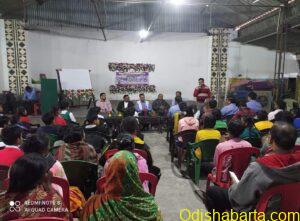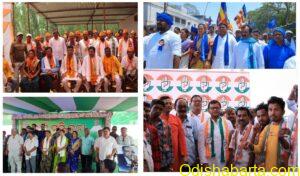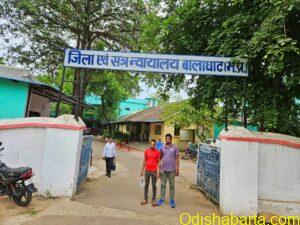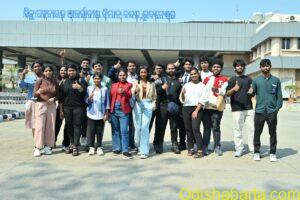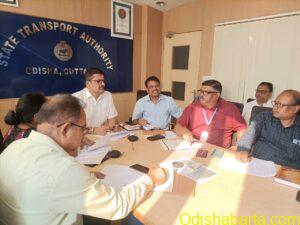Danduas in Odisha keep alive ‘dance of penance’
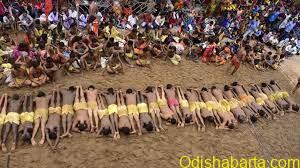
The rhythm of drums, cymbals and conch shells is now reverberating in the air in Ganjam district as groups of ‘Danduas,’ clad in saffron ‘dhotis,’ are marching with flags under the scorching sun.
BERHAMPUR: Even as many traditional folk art forms have faded from the cultural scene of the State, Danda Nacha continues to hold sway among people in Ganjam district. It is performed in ‘Chaitra’ month and this year, it began on Saturday.
Danda Naata or Danda Jatra is one of the most important traditional dance festivals organized in different parts of South Odisha and particularly in the Ganjam District, the heartland of ancient Kalinga Empire. The Danda Naata festival is being held in the month of Chaitra of every year. As per Ram Prasad Tripathy’s article, it is an ancient festival of the Kalinga kingdom and still alive in and around the ancient Kalinga capital Sampa or Samapa i.e modern day Jaugada of Ganjam district. The Participants of Danda are called Danduas (also known as Bhoktas) and they pray Goddesses Kali and Shiva during this 13-, 18- or 21-day Danda period.

Danda begins on an auspicious day before the Chaitra Sankranti or Meru Parba with traditional worship and fasting. The total number of days for the festival is 13, 18 or 21 days. Only male persons take part in this festival. The participants are known as the ‘Bhoktas’. All the `Bhoktas` or ‘Danduas’ lead a very pious life for all these days during the festival and they avoid eating meat, fish or cohabiting during this period.
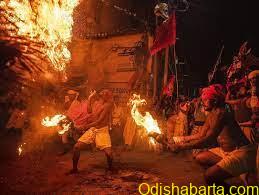
It is believed that the present day Danda Naata is a part of the ancient Chaitra Yatra festivals being celebrated every year at Tara Tarini Shakti Peetha. The Kalinga Emperors organised this Chaitra festival for their Ista devi, Tara Tarini. As per folk lore, during ancient period after 20 days of Danda practice the Danduas must assemble near Tara Tarini Shakti/Tantra Peetha (which is Ista devi of the Great Kalinga rulers) and with some hard rituals culminate their Danda on the last day.
The rituals of Danda Nacha (also known as dance of penance) entail painful procedures for worshipping goddess Kali and lord Shiva for 21 days. Generally, the rituals begin 21 ,18 & 13 days before Maha Bisuva Sankranti. The ‘Danduas’ also pray on behalf of the people, who want their wishes to be fulfilled.
During these days of penance, the ‘Danduas’ subject themselves to painful ordeals through innumerable ways to satisfy the Almighty. They stay away from their near and dear ones and take food only once in a day, that too without spices. The dance is performed in three phases __ Pani Danda, Dhuli Danda and Agni Danda.
While performing Dhuli Danda, the Danduas have to sleep on sand during day in scorching heat and after sunset, remain inside pond for more than one hour (Pani Danda). The last and most crucial phase, Agni Danda, begins at midnight when Kali and Shiva are worshipped together.
Unlike previous years, households and bazaar committees have been inviting the Danda Nacha troupes to perform the dance.
Each group of Danduas is led by a person called Patta Dandua (bhukta) who confines himself to a Kali temple and comes out on the Sankranti day after his group has performed the last rituals. Bhukta plays the most crucial role of pleasing the Goddess. He hangs himself upside down from a bamboo attached to two poles over a fire pit till blood oozes out of his nose. After the entire ordeal is over, the ‘Danduas’ go to the Kali temple to offer their gratitude to the Goddess for surviving the ordeals.
Despite restrictions and difficult rituals followed during the dance, the number of ‘Danduas’ has been increasing every year. Of late, the ‘Dandua’ groups are taking the assistance of some opera artistes to entertain the people, who are usually shocked to witness the stringent rituals from morning till midnight. The restrictions and rituals are, however, not imposed on the artistes, who participate only with an intention to earn for survival.
Apart from Ganjam, Danda Nacha is performed in Boudh, Kandhamal and Sambalpur districts. Although not much is known about the origin of the dance, historians opine that the dance may have originated 400 years ago.


